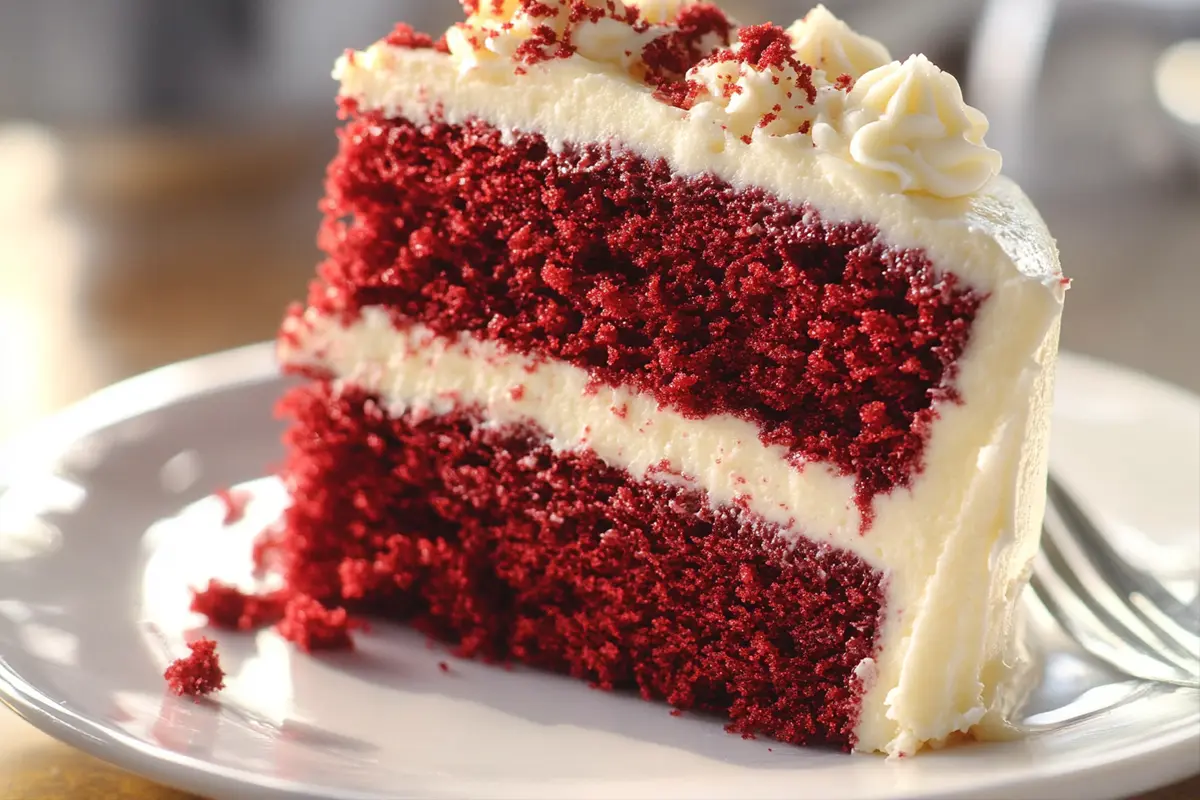Red velvet cake is famous not only for its vibrant red color but also for its unique flavor profile. It combines a subtle hint of cocoa with the tangy richness of buttermilk and vinegar, setting it apart from other types of cake. Though often confused with chocolate cake, red velvet has a flavor that is much more delicate and nuanced. In this article, we’ll explore the key factors that make red velvet cake taste different, the role of various ingredients, and why it remains such a popular dessert.
If you’re looking for a twist on this classic dessert, check out our Red Velvet Bundt Cake Recipe for a unique take on the traditional red velvet cake.
Introduction: What Defines Red Velvet Cake?
Red velvet cake has intrigued dessert lovers for decades. Though its bold red color makes it visually distinctive, its flavor is what makes it stand out. With a subtle cocoa flavor paired with the tanginess of buttermilk and vinegar, red velvet cake offers a taste that is both sweet and tangy. Unlike chocolate cake, where cocoa dominates, red velvet features a more delicate balance of ingredients that provide a lighter texture and flavor.
Interestingly, the history of red velvet cake dates back to the Victorian era. During that time, bakers softened cake textures with acidic ingredients like vinegar. This method laid the foundation for the cake we know today. By the 20th century, food coloring became the key to achieving the iconic red hue(Cakegirls)(Baking Kneads).
What Makes Red Velvet Cake Taste Different?
1. Subtle Cocoa Flavor
One of the defining characteristics of red velvet cake is its subtle cocoa flavor. Although cocoa is a core ingredient, it is used in much smaller quantities than in chocolate cake. This gives red velvet its mild chocolate taste without overpowering the other flavors.
Unlike chocolate cake, which is rich and intense, red velvet cake’s flavor is more balanced. The combination of cocoa, buttermilk, and vinegar adds complexity to the taste. Instead of dominating, the cocoa works with other ingredients to create a more nuanced profile.
2. The Role of Buttermilk and Vinegar
The unique taste of red velvet cake owes much to the interaction between buttermilk and vinegar. These acidic ingredients are essential in giving the cake its soft, tender texture while contributing to its signature tangy flavor. Buttermilk, in particular, brings a creamy richness that complements the mild cocoa flavor.
When buttermilk and vinegar combine with baking soda, they create a chemical reaction that makes the cake light and fluffy. This process also enhances the cake’s moistness, giving it a smooth, velvety texture. The tang from these acidic ingredients also balances out the sweetness of the cake, making each bite more satisfying.
3. Cream Cheese Frosting
A classic red velvet cake would not be complete without its iconic cream cheese frosting. This frosting adds a tangy richness that perfectly complements the cake’s soft, tender crumb. Cream cheese frosting enhances the overall flavor profile of the cake, making it richer without overwhelming the subtleties of the cake itself.
The slightly tangy frosting, combined with the subtle cocoa flavor of the cake, creates a perfect balance of sweet and savory. This is one of the reasons why red velvet cake continues to be such a popular dessert for weddings, birthdays, and special occasions.
4. Food Coloring and Visual Appeal
While food coloring doesn’t change the taste of the cake, it plays a major role in red velvet cake’s identity. Traditionally, the red color came from the reaction between natural cocoa powder and acidic ingredients like buttermilk. However, modern recipes rely on red food coloring to achieve the cake’s bold crimson hue.
Though the color does not affect the flavor, it has a psychological impact on how people perceive the cake. The striking red color adds to the appeal, making it visually exciting and more memorable.
Key Ingredients and Their Role in Red Velvet Cake
1. Cocoa Powder
Cocoa powder is essential to the flavor of red velvet cake, even though it is used sparingly. The cocoa provides a subtle chocolate undertone that complements the cake’s other flavors without dominating them. Natural cocoa powder, in particular, works best in red velvet cake as its acidity reacts with buttermilk and vinegar, enhancing the flavor and texture.
2. Buttermilk
Buttermilk is a critical component in red velvet cake, providing a slight tang and a creamy texture. It not only adds flavor but also reacts with other ingredients to produce the cake’s light, fluffy texture. Buttermilk ensures the cake stays moist while also contributing to its velvety crumb.
3. Vinegar
While vinegar may seem like an unusual ingredient in cake, it is essential to the chemistry of red velvet. When combined with baking soda, vinegar helps the cake rise and gives it a soft, tender texture. Additionally, vinegar enhances the tangy flavor that sets red velvet apart from other cakes.
4. Red Food Coloring
Although red food coloring does not affect the flavor, it has become synonymous with red velvet cake. Traditionally, the red color was the result of a reaction between cocoa and acidic ingredients. However, modern bakers use red food coloring to achieve a more vibrant hue(Cakegirls).
5. Cream Cheese Frosting
Cream cheese frosting is a staple in red velvet cakes, and for good reason. The frosting’s tangy, rich flavor complements the cake’s mild cocoa taste and soft texture. This pairing creates a perfectly balanced dessert that is both decadent and light(CakeRe).
Red Velvet Cake vs. Chocolate Cake
Flavor Comparison
At first glance, red velvet cake and chocolate cake may seem similar due to the presence of cocoa powder. However, red velvet cake has a much milder cocoa flavor compared to the rich, intense flavor of chocolate cake. Additionally, the tang from the buttermilk and vinegar sets red velvet apart from chocolate cake, which typically lacks the acidity that characterizes red velvet.
Texture Comparison
In terms of texture, red velvet cake is noticeably lighter and more tender than chocolate cake. The use of acidic ingredients like buttermilk and vinegar in red velvet cake gives it a fluffier texture, while chocolate cake tends to be denser due to the higher amount of cocoa and sometimes melted chocolate
FAQs
What flavor is red velvet cake?
Red velvet cake has a subtle cocoa flavor with a distinct tanginess from the buttermilk and vinegar. It’s often described as a lighter, more nuanced chocolate flavor with a creamy richness from the cream cheese frosting.
Does red velvet cake taste like chocolate cake?
No, while red velvet cake contains cocoa, it has a much milder chocolate flavor compared to traditional chocolate cake. The addition of buttermilk and vinegar gives it a unique, tangy taste that distinguishes it from chocolate cake.
What gives red velvet cake its red color?
Traditionally, the red color in red velvet cake came from a reaction between natural cocoa powder and acidic ingredients like buttermilk. Today, most recipes use red food coloring to achieve the vibrant hue.
Conclusion: The Unique Taste of Red Velvet Cake
What makes red velvet cake taste different is its delicate balance of flavors and textures. The subtle cocoa flavor, combined with the tangy richness of buttermilk and vinegar, gives the cake a unique taste that is both complex and delicious. Cream cheese frosting enhances the flavor, making each bite indulgent without being overwhelming.
While red velvet cake is often confused with chocolate cake, its lighter texture and balanced flavor set it apart. Whether you’re a fan of its velvety texture or the iconic red color, red velvet cake offers a delightful experience that continues to captivate dessert lovers around the world.

